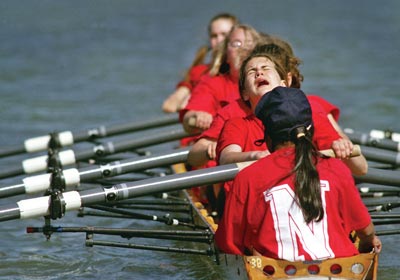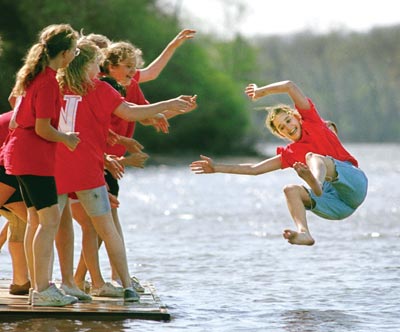
Just Say Row
Niskayuna crew team pulls together
It’s a perfect afternoon for rowing. The water under the Rexford Bridge is smooth as glass. There isn’t a hint of wind. Above the water, the commuter rush is backed up on the bridge spanning the Mohawk river.

The idling cars are only 30 feet over his head, but they could be a million miles away as far as Matt Hopkins is concerned. Hopkins, the varsity crew coach at Niskayuna High School, has his mind and eyes on the long, slim racing shell just ahead of the motorboat.
As the graceful form knifes through the water, the student coxswain and crew concentrate on achieving perfect rowing rhythm, the unanimity of effort that rowers call “swing.”
“It’s definitely a very unique team experience,” says Hopkins, who guides the team with novice coach Nan Kuntz.
“There are no high scorers. You can’t have someone who runs away with the ball and wins it for you. Everyone crosses the line at the same time – big, small, weak, or strong.”
Hopkins feels it is that chance for team identity that has attracted many of the students on the 70-strong Niskayuna squad.
“The level of teamwork that we require demands some pretty incredible self-sacrifice,” he says.
Team members practice at least three hours a day, five days a week. Racing meets are all-day affairs. Rowing is also strenuous. It’s one of the few sports in which all muscle groups are used.
 Rower’s feet remain stationary in shoes that are mounted on “stretcher” racks bolted to the hull. The seats slide back and forth on rails, and it’s this arrangement that lets the legs supply 70 percent of the power that propels the boat.
Rower’s feet remain stationary in shoes that are mounted on “stretcher” racks bolted to the hull. The seats slide back and forth on rails, and it’s this arrangement that lets the legs supply 70 percent of the power that propels the boat.
It also makes for an exhausting workout. “What every race boils down to is which group of people can take the most pain and keep going,” says Hopkins. “By the end of a 1500 meter race, if everything is going according to plan, each rower has exhausted their aerobic capacity”.
There are also costs that time and athletic ability will not cover. Funds must be raised to buy equipment. A fully equipped eight-man shell can cost $15,000.
The hull and oars of the boats are a composite of high-tech carbon fiber and fiberglass. In the stern, an electronic “cox box” helps the coxswain guide the boat with a combination amplifier, timer, and stroke meter. A headset microphone and small speakers let the coxswain talk to the crew as they row.
“I have never heard a coxswain yell ‘Stroke’,” says Hopkins with a chuckle, debunking one of the sport’s most common myths. “That’s something that people yell from trucks going over the bridge.”
Niskayuna’s club depends upon its parent organization for fund raising and equipment. A team without supportive parents won’t last long. Outside of the team, recognition has been mixed since the group was organized, according to Hopkins.

“The school administration understands and appreciates us very much,” he says “But I would bet that most of the kids on campus don’t know where the boathouse is.”
But recognition, he adds, is not what attracts participants to crew racing. The grace, strength, and romance of the sport are highlighted when he occasionally looks up at the bridge overhead.
“I am really, really grateful every time I go under that bridge and see all those commuters piled up there, coming from flourescent-lit offices,” says Hopkins.
“I’m so grateful I’m down here in a beautiful place, amidst beautiful boats, full of people striving for greatness.”
“That’s really what it is.”